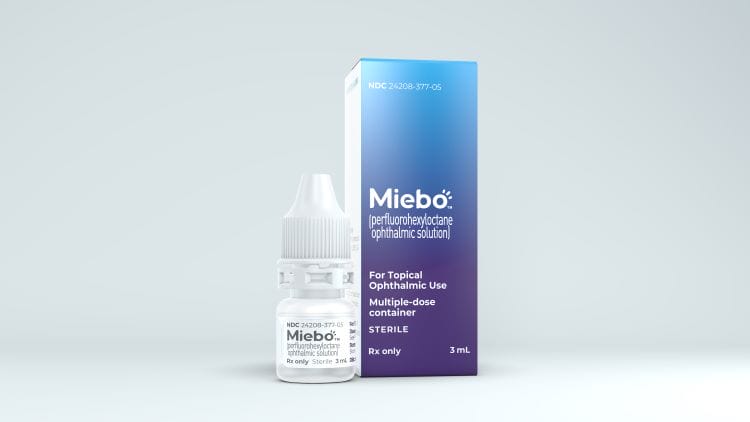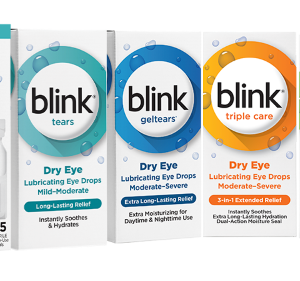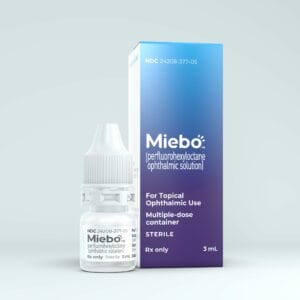September 14, 2023
VAUGHAN, Ontario — Bausch + Lomb Corporation has announced the U.S. commercial launch of Miebo (perfluorohexyloctane ophthalmic solution) for the treatment of the signs and symptoms of dry eye disease (DED). Miebo is the first and only prescription eye drop approved for DED that directly targets tear evaporation.
“More and more Americans are suffering from dry eye disease, due in large part to today’s multi-screen lifestyles,” said Andrew Stewart, president, Global Pharmaceuticals and International Consumer, Bausch + Lomb. “With Miebo, eye care professionals now have a prescription eye drop that directly addresses tear evaporation, the leading cause of dry eye disease.”
DED affects more than 38 million Americans, with approximately nine in 10 experiencing evaporative dry eye.1,2 When not addressed, tear evaporation may lead to worsening of the condition by triggering a cycle of inflammation and ocular surface damage.3,4 Miebo is a single ingredient, water-, preservative- and steroid-free prescription eye drop that spreads quickly and comfortably. It is designed to address the signs and symptoms of DED by reducing tear evaporation at the ocular surface.5-7
The U.S. Food and Drug Administration (FDA) approved Miebo in May 2023, based on consistent results from two pivotal phase 3 trials. Its clinical development program includes the first and only phase 3 program for any FDA-approved prescription DED product composed entirely of patients with both DED and clinical signs of meibomian gland dysfunction (MGD). MGD is a major cause of DED development and progression, with approximately 86% of people with DED having excessive tear evaporation associated with MGD.2 In the clinical trials, Miebo delivered significant improvements in the signs and symptoms of DED and consistently met its primary clinical sign and patient-reported symptom endpoint. The most common adverse reactions experienced with Miebo was blurred vision (1% to 3% of patients reported blurred vision and eye redness).
About Miebo Phase 3 Clinical Trials
FDA approval of Miebo was based on results from two 57-day, multi-center, randomized, double-masked saline-controlled studies, GOBI and MOJAVE. The studies assessed a total of 1,217 patients who received Miebo or hypotonic saline (0.6%) in a 1:1 ratio.8,9
In these studies, Miebo met both primary sign and symptom efficacy endpoints. The two primary endpoints were change from baseline at week eight (day 57 ± 2) in total corneal fluorescein staining (tCFS) and eye dryness Visual Analog Scale (VAS) score. Patients experienced relief of symptoms as early as day 15 and through day 57 with statistically significant reduction in VAS eye dryness score favoring Miebo observed in both studies. Additionally, at days 15 and day 57, a significant reduction in tCFS favoring Miebo was observed in both studies.
References
1 Downs P. 2020 Dry Eye Products Market Report: A Global Analysis for 2019 to 2025. Market Scope; 2020.
2 Lemp, MA, Crews, LA, Bron AJ. (2012). Distribution of Aqueous-Deficient and Evaporative Dry Eye in a Clinic-Based Cohort: a retrospective study. Cornea, 31(5), 472-478. 2012;31(5):472-478. doi:10.109/ICO.0b013e318225415a.
3 Craig JP, Nelson JD, Azar DT, et al. TFOS dews II report executive summary. Ocul Surf. 2017;15(4):802-812. doi:10.1016/j.tos.2017.08.003.
4 Baudouin C, Messmer EM, Aragona P, et al. Revisiting the vicious circle of dry eye disease: a focus on the pathophysiology of meibomian gland dysfunction. Br J Ophthalmol. 2016;300-203. doi:10.1136/bjophthalmol-2015-307415.
5 Data on file.
6 Nichols KK, Foulks GN, Bron AJ, et al. The international workshop on Meibomian gland dysfunction: executive summary. Invest Ophthalmol Vis Sci. 2011;52(4):1922-1929. doi:10.1167/iovs.10-6997a
7 Borchman D, Vittitow J, Ewurum A, Veligandl SR. Spectroscopic study of perfluorohexyloctane human Meibum interactions. Invest Ophthalmol Vis Sci. 2022;63:1525.
8 Tauber J, Berdy GJ, Wirta DL, et al. NOV03 for dry eye disease associated with meibomian gland dysfunction: Results of the Randomized Phase 3 GOBI Study. Ophthalmology. 2023;130(5):516-524. doi:10.1016/j.ophtha.2022.12.021.
9 Sheppard J, Kurata F, Epitropoulos AT, et al. NOV03 for signs and symptoms of dry eye disease associated with meibomian gland dysfunction: The randomized phase 3 Mojave study. American Journal of Ophthalmology. 2023;252:265-274. doi:10.1016/j.ajo.2023.03.008.





